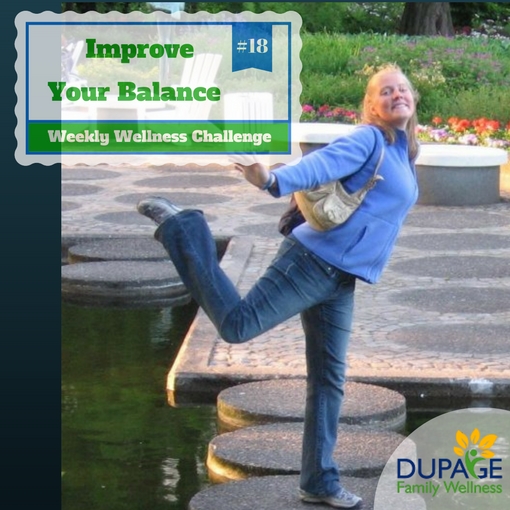
Balance is often overlooked, yet it is an important component of healthy movement. If we can’t balance, we aren’t stable. If we aren’t stable we don’t have a platform for our joints to move from. If we don't a platform to move from, our muscles become "tight" to try to create more stability.
How did we get into this situation?
Do you spend most of your day sitting? This takes very little “balance", especially if you are leaning back on the chair or couch. When you stand or walk, it is probably on flat ground with flat shoes. Most surfaces are cement, paved, or otherwise "flattened". Think about it .... How often do you challenge your body’s systems to balance? Our ancestors had a more adventurous life. They walked on non-uniform surfaces (e.g. fields, forests etc.) to perform daily outdoor activities and even used logs and stepping stones to cross rivers.
Benefits of Balance
Studies link balance training to injury prevention both in athletes and seniors. Balance training was found to be more helpful that stretching for injury prevention. Specifically it has been linked to reduction in ankle sprains and ACL injuries. In older individuals, balance is the key to reducing the risk of falls, which can lead to broken bones and other serious complications.
Whether you are young or old, balance is important for improving your stability as you move.
How Does Balance Work?
Your body has 3 systems that work together to help you balance:
- Nerve fibers called proprioceptors on the bottoms of your feet: These send signals up to your brain, telling it how much pressure is on each part of your foot. Your weight shifts accordingly to stay centered and stable.
- Vision: Your eyes focus on the horizon or a stable object, and send signals to your brain. These help the brain understand where the head is in space so that it can stabilize your body.
- Ear Canals: You have 3 semi-circular canals in your ears filled with fluid. One canal is in each plane. As your head moves, the fluid shifts and stimulates receptors to let your brain know where your head is at in space.
Balance is easiest when both feet are on a stable surface, your eyes are open, and your head is still. Removing any one of these systems (i.e. lifting a foot or standing on an unstable surface, closing our eyes, or moving our head around) makes balancing much more difficult.
Test Your Balance
Can you stand on one foot for 60 seconds without touching the other foot to the ground? If not, you need some practice! Even if this is easy for you, there are still ways to further improve your balance by only utilizing 1 or 2 of the above systems as opposed to all 3! Here are some tips.
Improve Your Balance
Fortunately, balance can be improved if you work on it! Like other forms of movement, the “use it or lose it” principle applies. If you don’t use the systems that your body has put in place for balance, they become less effective. Over time, your balance will get worse. The good news, is that you can turn this around.
Here are a few ideas for you to improve your balance:
- Practice Balancing: Use the principles above to challenge your body. Start with simply balancing on one foot on a stable surface. Once you are good at this and can do it for a full minute, try challenging yourself by standing on a folded blanket, pillow, grass or sand (unstable surface), closing your eyes, or moving your head around while balancing.
- Find Uneven Surfaces to Explore: Get out in nature and find some naturally unstable or narrow surfaces explore. This could mean hiking over roots and rocks. Anything that isn’t perfectly flat like a floor will start to challenge your body and force it to improve its ability to stabilize you. Even if you are in a parking lot you can practice walking on a man made balance beam such as a parking curb.
- Try a class or activity that gets your body doing alternative movements:. For example, in a dance class you control your body through all sorts of movements, often with only 1 foot on the ground. Other ideas include Tai Chi, Martial Arts, playing a game like raquetball, tennis, or pickleball.
Looking for a class? Here are a few local options that I love!
Zumba- While zumba isn't solely focused on balance, it does involve moving your body in all sorts of positions- many of which are on one foot. It is a Latin Dance workout class that feels more like a party than exercise! There is a local instructor named Tom that puts on by far the best Zumba class I've ever gone to! His energy is contagious he makes moving fun! If you haven't tried it, he teaches at Fit to be You- a new studio in Naperville!
Nia- I recently attended a Nia class. Nia is another dance fitness class that emphasizes joint mobility, stability, flexibility, balance, and body awareness. It is done barefoot (so all of the little joints in your feet can freely move and aren't restricted by shoes). It is totally adaptable for all age and fitness levels. It is taught at Warrenville Park and Wheaton Sports Center if you are local. If not, you can visit www.nianow.com to find a class near you!
So your challenge this week is to incorporate more balance into your life! This can be through simply practicing with the strategies listed above, exploring uneven surfaces, or finding a class to attend! I'd love to hear how it goes- or if you have any other ideas for improving your ability to balance! Chat with me on my facebook page!
-Dr. Jamie Thomure

